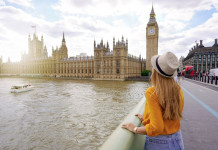London is home to many architectural and engineering marvels, and nowhere is this more evident than in its array of stunning bridges. There are a wide variety dotted throughout the city, many of which are interlinked with the history of the city itself.
In this blog, we’ll take a closer look at some of the most impressive bridges you’ll find on your next visit to London…
Tower Bridge
This remarkable bridge is one of the most easily identifiable symbols of London. The structure is named after the Tower of London, which is close to the bridge itself. It was built in 1894 in a Victorian Gothic style; Tower Bridge stretches across Southwark and Tower Hamlets, and is so well known that it is often mistaken for its neighbour, London Bridge, located around half a mile away.
Tower Bridge offers striking views, and has become a popular destination for visitors staying in the city. For those staying at a Bayswater Hotel in London, its easy to access the bridge and spend a day sightseeing. The walkways of Tower Bridge provide particularly panoramic vistas of the surrounding skyline, so be sure to take a camera.
There’s also a lot more to visiting Tower Bridge than simply seeing the bridge itself up-close. If you’re really eager to find out more about the history and heritage of the bridge, then there are a range of different tours which uncover all this information in vivid detail. In addition, the Tower Bridge Exhibition room allows you to see the River Thames from above, while providing access to the Victorian-era engine rooms which once helped operate the lift mechanism on the bridge itself.
Westminster Bridge
This pedestrianised bridge connects Lambeth and Westminster. Its painted green, and provides a walkway and road for thousands of visitors each day eagerly travelling through London. As with many of the bridges on this list, Westminster Bridge has become a notable symbol of the city, and provides instant visual shorthand for visual media representing London.
Its first incarnation was developed during the 1700s by Swiss architect Charles Labelye, but a replacement was commissioned in 1854, with Thomas Page taking charge of design and construction. The bridge has seven distinctive archways, notable for their Gothic style – these elements were created by Charles Barry.
The bridge opened to the public in 1862, and was designed to work aesthetically in conjunction with the nearby Parliament buildings. History fans staying at the Grand Royale Hotel London will enjoy a trip here, and can also incorporate visiting the bridge with their general explorations around the city.
Millennium Bridge
This steel suspension bridge differs from some of the other entries to this list, as it is relatively new by comparison. First opened for pedestrian access in 2000, it was created to celebrate the new Millennium, and is sometimes known better as the London Millennium Footbridge. The bridge links Bankside and the City of London, spanning the River Thames.
The bridge has a distinctive structure, with architectural elements which make it stand out from the more historic bridges in the city. During its earliest years, Millennium Bridge was nicknamed the ‘Wobbly Bridge’ by some Londoners due to its mild ‘swaying’ effect when crossing the river. Considerable work was undertaken to help remove this motion, with the bridge closing for around two years so it could be corrected and safety ensured.
Millennium Bridge was designed following a competition held during 1996, which was ultimately won by the Arup Group, Foster and Partners and Anthony Caro. Before construction, some elements of the design were altered to help provide better views for those using the bridge. It is another of London’s iconic additions, and has featured heavily in film and television, as well as a number of notable music videos.
The southern side of the bridge is close to many of London’s key attractions, including the Globe Theatre and St Paul’s Cathedral.
London Bridge
London Bridge is another of the more modern bridges included on this list, having first opened to the public in 1973. It was developed as a replacement for an earlier bridge, which originated in the 19th century.
There have been many bridges in the city simply titled London Bridge, though this particular structure is the contemporary owner of this title. The bridge was built using a mixture of steel and concrete, and prior to its 19th century counterpart’s construction, there had once been a medieval bridge in the same spot – as well as evidence to suggest a bridge has existed in the site known as London Bridge ever since the Roman occupation.
The modern bridge is maintained and owned by Bridge House Estates, a charity first founded in the medieval period. It was designed by Lord Holford, a notable architect, and engineering talents Mott, Hay and Anderson. Construction began in 1967 and was completed in 1972, before being opened officially by Queen Elizabeth II the following year.
London Bridge is another significant part of the city’s culture, and close to a number of local tube stations. This ensures easy access for anyone staying at discount hotels in Bayswater.
Vauxhall Bridge
This bridge is one of the most important in London. It opened in 1906 and has since developed into an integral part of London’s transport system. Its also achieved a Grade II listing, as a signifier of its importance and historical significance.
The bridge was built as a replacement of Regent Bridge, which had been opened in 1816. Both bridges endured a problematic construction process, with several redesigns and a number of different problems which delayed construction.
The current bridge was developed with a functional style, which led many architects to ponder how it could be made a little more creative. As a result of these discussions, architect Richard Norman Shaw added bronze statues to the piers, giving it a more decorative look and feel.









